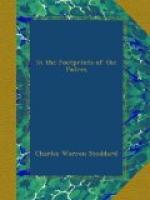He liked the crumbling estate, and even as much of it as had gone down into the depths forever. He liked the sagging and sighing cypresses, with their roots in the air, that hung upon and clung upon the rugged edge of the remainder. He liked the shaky stairway that led to it (when it was not out of gear), and all that was irrelative and irrelevant; what might have been irritating to another was to him singularly appealing and engaging; for he was a poet and a romancer, and his name was Robert Louis Stevenson. He used to come to that eyrie on Rincon Hill to chat and to dream; he called it “the most San Francisco-ey part of San Francisco,” and so it was. It was the beginning and the end of the first period of social development on the Pacific coast. There is a picture of it, or of the South Park part of it, in Gertrude Atherton’s story, “The Californians.” The little glimpse that Louis Stevenson had of it in its decay gave him a few realistic pages for The Wrecker.
I have referred to the surprising interiors of the city in the Fifties. What I meant was this: there was not an alley so miserable and so muddy but somewhere in it there was pretty sure to be a cottage as demure in outward appearance as modesty itself. Nothing could be more unassuming: it had not even the air of genteel poverty. I think such an air was not to be thought of in those days: gentility kept very much to itself. As for poverty, it was a game that any one might play at any moment, and most had played at it.
This cottage stood there—I think I will say sat there, it looked so perfectly resigned,—and no doubt commanded a rent quite out of proportion to its size. It had its shaky veranda and its French windows, and was lined with canvas; for there was not a trowel full of plaster in it. The ceiling bellied and flapped like an awning when the wind soughed through the clapboards; and the walls sometimes visibly heaved a sigh; but they were covered with panelled paper quite palatial in texture and design, and that is one thing that made those interiors surprising.
At the windows the voluminous lace draperies were almost overpowering. Satin lambrequins were festooned with colossal cord and tassels of bullion. A plate-glass mirror as wide as the mantel reflected the Florentine gilt carving of its own elaborate frame. There were bronzes on the mantel, and tall vases of Sevres, and statuettes of bisque brilliantly tinted. At the two sides of the mantel stood pedestals of Italian marble surmounted by urns of the most graceful and elegant proportions, and profusely ornamented with sculptured fruits and flowers. There was the old-fashioned square piano in its carven case, and cabinets from China or East India; also a lacquered Japanese screen, marble-topped tables of filigreed teek, brackets of inlaid ebony. Curios there were galore. Some paintings there were, and these rocked softly upon the gently-heaving walls. As for the velvet carpet, it was a bed of gigantic roses that might easily put to the blush the prime of summer in a queen’s garden.




